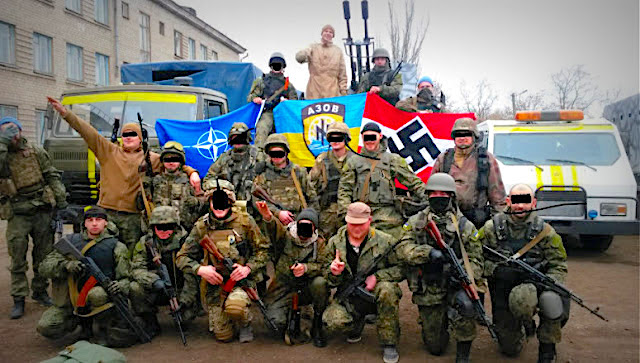In the essay “Why ‘Nazis’ in Ukraine?,” I looked at the historical basis for significant remnants of interest in National Socialism as a political ideology in Ukraine. That essay was not the place to evaluate whether the famous—or infamous—Azov Regiment (formerly Battalion) is National Socialist in any sense. We will evaluate that here.
The Azov Regiment displays flags, patches and other regalia featuring a symbol associated with the National Socialist German military from World War II. Something called Reporting Radicalism gives a good description of the main Azov symbol, as well as a good example of how it can be mischaracterized:
Idea of the Nation
A modern symbol created as an emblem for the Social-National Party of Ukraine (now known as the Svoboda Party). It is a combination of Ukrainian letters “I” and “N” allegedly written in an “ancient script,” though there is no evidence that these letters were ever written in such a way. The symbol is a variation of the Wolfsangel; a mirror image of the emblem of the SS Panzer Division “Das Reich” (a division of the Nazi security services). The leader of Patriot of Ukraine rejects the notion that the symbol has any connection to the Wolfsangel. However, the organizations that use the Idea of the Nation symbol are far-right and use other hate symbols.
Before the beginning of the Russian war with Ukraine in late February 2022, media attention had been invested in presenting Azov as “Neo-Nazis,” Fascists and “far right extremists.”
This is especially true of Russian media, such as this RT depiction titled “Not worth your sympathy: The story of Ukraine’s neo-Nazi Azov battalion” released in July of last year, equating Azov with the original racist, mass murdering, evil “Nazis.”
Only six days after the Russian “special military operation” began, in early March Aljazeera did a fine job demonizing Azov in its piece “Profile: Who are Ukraine’s far-right Azov regiment?,” assigning it all the same atrocities attributed to “Nazis” such as “pogroms” against Roma and homosexuals (but not Jews), “white supremacist” and “far-right ultra-nationalism” ideology, and raping and torturing civilians in the Donbas region.
Aljazeera mentions “Igor Kolomoisky, an energy magnate billionaire and then-governor of the Dnipropetrovska region” as an oligarch who funded Azov, but omits that Kolomoisky is Jewish. This will prove significant.
Not to be left out, Western media such as The Nation was depicting Azov in a similar vein in 2019 even before the Russian incursion, using every label imaginable just in its title and subtitle: “Neo-Nazi,” “far right,” “anti-Semitic,” “fascist” and “ultranationalist.”
As far back as June 2015, the US Congress was passing an amendment to the Department of Defense Appropriations Act which stated: “None of the funds made available by this Act may be used to provide arms, training, or other assistance to the Azov Battalion.”
The reasons were provided by a Mr. Conyers, sponsor of the amendment:
Foreign Policy magazine has characterized the 1,000-man Azov Battalion as “openly neo-Nazi” and “fascist.” Numerous other news organizations, including The New York Times, The Guardian, and the Associated Press have corroborated the dominance of White supremacist and anti-Semitic views within the group; yet Ukraine’s Interior Minister recently announced the Azov Battalion will be among the units to receive training and arms from Western allies, including the United States.
Azov’s founder, Andriy Biletsky, organized the neo-Nazi group the Social-National Assembly in 2008. Azov men use neo-Nazi symbolism on their banner.
Facebook took a similar view of Azov, then moderated it. In 2016 Facebook declared Azov a “dangerous organization,” and by 2019 Azov was banned from Facebook entirely. “Users engaging in praise, support or representation” of Azov were also banned.
The day after the Russian offensive, February 24, 2022, Facebook abruptly changed the policy, allowing praise and support for Azov.
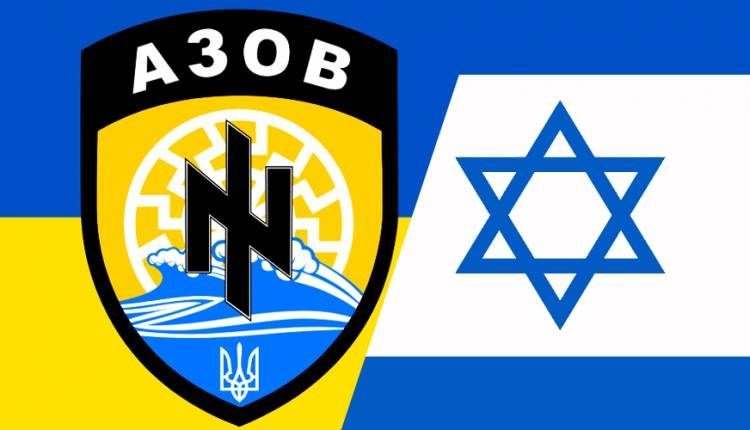
In a vain and desperate attempt to find some non-existent middle ground, Facebook will “allow praise of the Azov Battalion when explicitly and exclusively praising their role in defending Ukraine OR their role as part of the Ukraine’s National Guard,” but that “Azov still can’t use Facebook platforms for recruiting purposes or for publishing its own statements and that the regiment’s uniforms and banners will remain as banned hate symbol imagery…”
This moderation by Facebook is typical of Western media generally after the Russian intervention in early 2022.
Azov had already been the focus of intensive propaganda warfare prior, which escalated when Putin declared “de-nazification” as a main objective of Russia’s direct entry into the conflict.
Russian propaganda depicts Azov as “Neo-Nazis” and even “White supremacists” as one justification for crossing the border into Ukraine.
Azov has its own highly polished and professional propaganda, which labeled the Russians “the real fascists.” The UK Telegraph said Azov was “playing a PR game” as a “well-oiled publicity machine.”
International news outlet France 24reported in late March 2022 that Azov maintains a professional presence on Telegram social media, posting drone videos of Azov’s military successes against Russian tanks.
The article states, “The Azov now function like other regiments ‘but with better PR,’” according to a human rights expert.
More typical “de-nazification” of Azov that Western media itself engaged in at this point declares: “'(Azov) doesn’t have the connotation of being a sort of fascist symbol anymore,’… Overall, ultra-nationalist political forces have been on the decline in Ukraine since 2014…”
These apologetics and white-washing of Azov should perplex us, given the absolute hysteria with which the Jewish-owned and -operated Western media and governments depict anything even remotely considered “Nazi.”
One example was the frenzy that ensued when it appeared the stage at the Conservative Political Action Committee (CPAC) was shaped in the form of a Nordic rune (the Odal), also displayed by some National Socialist military units.
Obviously the Russian invasion in 2022 changed something fundamental and now it is acceptable to exonerate Azov from “Nazi” affiliations and even praise it.
At the time of the dramatic confrontation in Mariupol between Azov barricaded in a steel plant, and Russian forces besieging them in May 2022, some surprising (to those who remain perplexed) developments occurred.
Some media attention was devoted to showing Azov as definitely not “Nazis,” but devoted Ukrainian fighters trying to resist the Russian invasion of their lands. These accounts seek to further sever the association between Azov and “Nazis,” and even re-associate Azov with Jews!
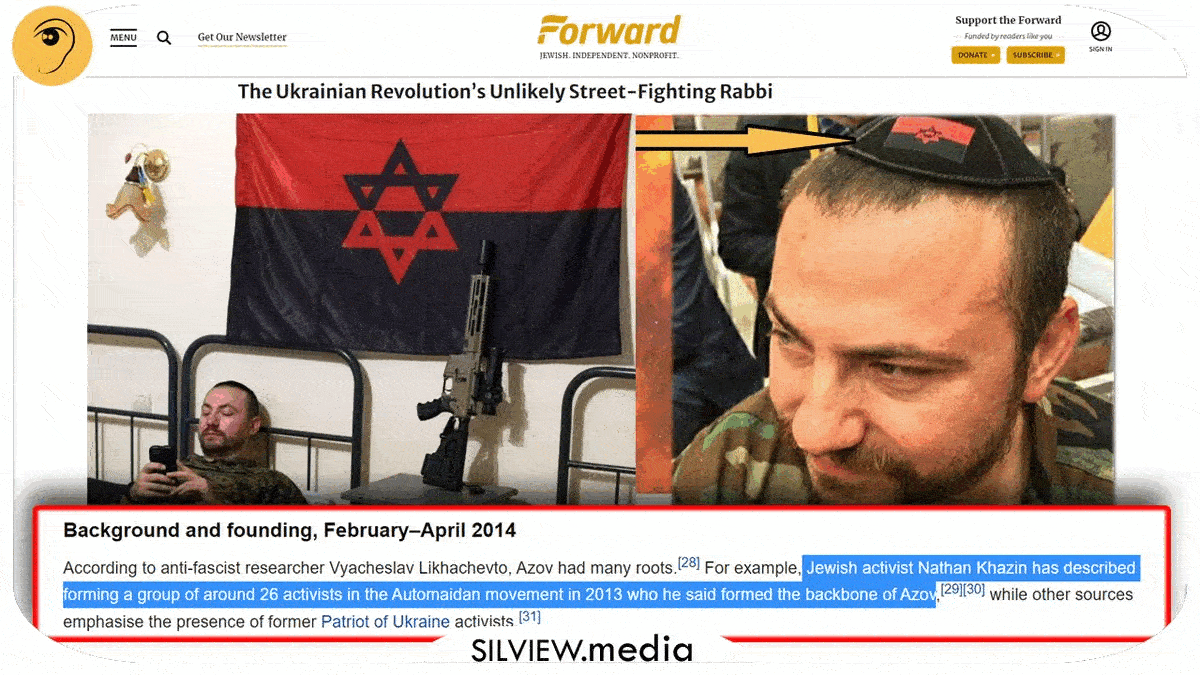
To counteract Russian accusations, Ukrainian news outlet Gordonua quoted an Azov deputy commander: “I want to emphasize that these (Azov people) are not militants. These are military personnel of Ukraine, these are citizens of Ukraine of different nationalities. These are Jews, these are Ukrainians, these are Greeks, these are Belarusians, these are Gagauz.”
Jews in the ranks of “Nazi” Azov?
Apparently so. A Jew trapped inside the steel plant with Azov sent a video message out, directed to Israeli Prime Minister Naftali Bennet, the people of Israel, its journalists, Rabbis, and others, as reported by Ukrainian news Focus.
Vitaly Barabash published his video on the Ilgam Hasanov Facebook page “on behalf of all Jews who are in the blocked ruins of Azovstal” (name of the steel plant). How many Jews are there with—in—Azov?
Enough to make this appeal to Israel.
The next day on May 12, Haaretz quoted the same Azov deputy commander in its article titled “Azov Battalion’s Second-in-command: ‘Like in Israel, There Is Also Terror Against Us. We Are Not Nazis‘” The relevant passage states:
…a video appeared on social media of a coast guard fighter who identified himself as Jewish from another unit inside the Azovstal plant, in which he appealed to Israeli lawmakers. He addressed Prime Minister Naftali Bennett and Russian-speaking Knesset members Yuli Edelstein of Likud and Evgeny Sova, Yulia Malinovsky and Alex Kushnir of Yisrael Beiteinu and asked that Israel help evacuate the Ukrainian forces from Mariupol.
“He addressed your politicians and the nation of Israel,” says (Azov deputy commander) Palamar. “He thinks, and so do I, that Israel is a strong country that has been fighting for a long time and that protects its soldiers.
We know that Israel takes the members of its military seriously, who defend your country from both territorial attacks and from terrorists who carry out attacks. The same thing is happening here. I think this is terror.”
Yes, an appeal by a Jew closely associated with Azov, for help from Israel, “a strong country that has been fighting for a long time,” to intervene and rescue all the Jews in the steel plant. The article is framed as a question and answer session with the deputy commander.
Haaretz:The Azovstal plant is already being compared to Masada, where Jewish fighters who rebelled against the Roman Empire barricaded themselves in, and in the end all of them were killed. Do you understand that this could be your fate, too?
Azov: “Every minute. Any minute, we are expecting to be killed.”
In fact, the Jews within Masada committed mass suicide rather than be captured or slaughtered by the Romans. This was considered a brave act of faith, and is the essential meaning of the story.
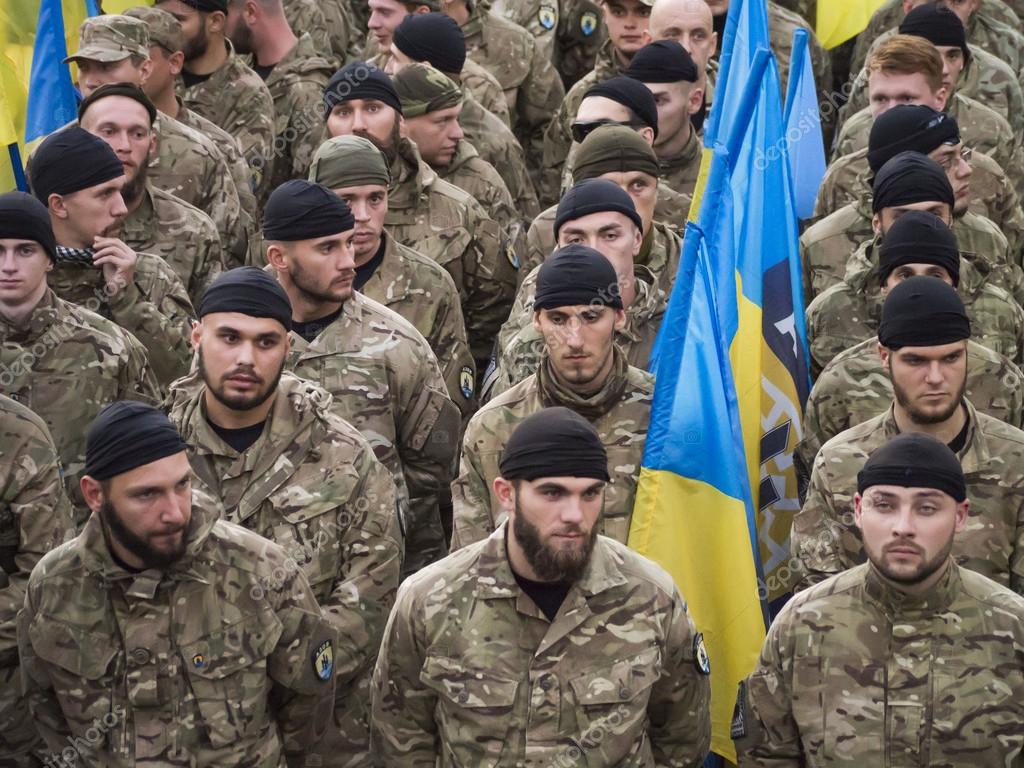 Ukraine is the homeland of those Jews who settled in Israel after wwII, the Khazar Jews who converted to judaism
Ukraine is the homeland of those Jews who settled in Israel after wwII, the Khazar Jews who converted to judaism
For Haaretz to get this wrong cannot be a mistake. Haaretz certainly cannot suggest suicide for Azov and the Jews in Mariupol, and so the story is distorted for propaganda purposes.
The meaning of the Mariupol story is for Israel to rescue brave fighters against imperialism (this time Russian instead of Roman), to avoid the tragedy of a modern Masada.
Finally the interview devolves into Azov “Nazi” denial. This is astounding in a Jewish Israeli outlet such as Haaretz, so we will examine it in full.
Haaretz: The Russian propaganda is claiming that you are Nazis. But in addition to the propaganda, there have been testimonies for years in independent media outlets and in international reports that Azov fighters hold extreme rightist positions.
Azov: What is Nazism? When someone thinks that one nation is superior to another nation, when someone thinks he has a right to invade another country and destroy its inhabitants — this is terror, this is violence, these are crematoria and filtration [sic; concentration?] camps. This is clinging to one religion or one idea. What is happening here? We believe in our country’s territorial integrity. We have never attacked anyone, and we have not wanted to do that.
Our unit came together when our country was attacked [in 2014], and our highest priority is defending our country. We do not think, and we have never thought, that we are better than anyone else. People from different nationalities are serving with us – Greeks, Jews, Muslims, Crimean Tatars — and even if at one time there were soccer hooligans among us who shouted things in stadiums, those are the positions of young people who have changed because we are a military unit. We have no political ambitions or stances. Only citizens of Ukraine are serving with us. There are no foreign citizens with us because that is prohibited by law.
Haaretz: A few days ago, I spoke with a former resident of Mariupol, She claimed that Azov fighters walk around with Nazi symbols, with swastikas. Is that a lie?
Azov: They’re talking about our symbol, ‘the idea of the nation.’ Its meaning is that the main idea of what was once a regiment and is now our battalion is the defense of our national ideals. I think that every civilian and soldier in every nation — that’s his idea, because it’s incumbent on everyone to defend their national interests, especially if the country gives them weapons.
Haaretz: Nevertheless, I want to be precise here. Can you say that the fighters of the battalion do not have actual swastikas tattooed on their bodies?
Azov: There are no swastikas. It could be that there are inscriptions in ancient Slavic letters, or a pagan runic inscription. Every individual among us can believe whatever he wants here in the unit. We all live in peace.
No swastikas in Azov, just Jews and peace. A few young soccer hooligans, a couple pagan rune tattoos. No “Nazis” here! Is Azov “denazifying” itself to remove one of Putin’s reasons to invade?
To recruit support from the West? To Jews, “Nazi” denial must be almost as heinous as holocaust denial, yet Jews themselves are supporting and propagating it in regard to Azov.
The antagonism between National Socialist German leadership and Jewish Communists and bankers could not have been more acute. Anything National Socialist, then or today, is by definition “anti-Semitic.”
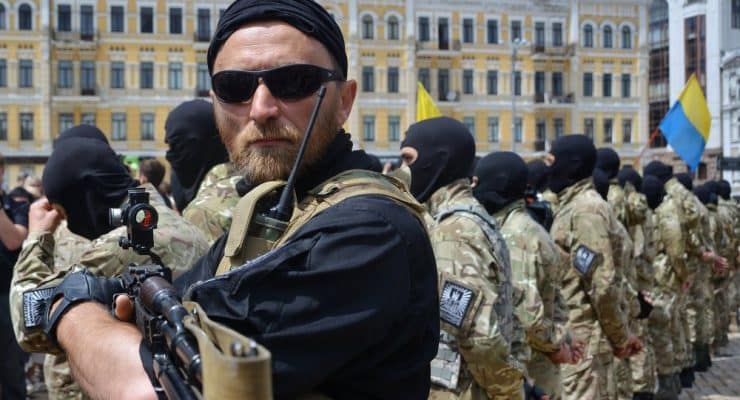
To see Azov, which had been so thoroughly demonized as “Nazi” now harboring Jews in its ranks and associated forces, funded by a Jewish oligarch, white-washed by Jewish media, and sanctioned and approved by the Jewish President of the nation of Ukraine, is so incongruous that it can have only one explanation: Azov is now a propaganda creation serving a dual schizophrenic purpose.
It can be depicted as a gang of evil “Nazis” committing atrocities and war crimes to perpetuate the evil “Nazi” mythology and absorb all accusations of Ukrainian atrocities. It can also be depicted as a band of brave multi-cultural freedom fighters resisting Russian imperialism.
Whichever suits the purposes of the Western media. The second depiction sounds oddly similar to the Waffen SS, the first ethnically diverse all-European army which fought on the side of National Socialism against Communism.
The Azov propagandists do not want us to see that, though.
Then again, plenty of Jews—up to 150,000—fought for Germany in World War II, and 77 of Germany’s officers, some of high rank, were Jews. Could this explain why Jews serve in Azov today? We should not believe it.
Azov changes its colors with the circumstances of war and the needs of Western propaganda. Russian propaganda remains constant: Azov is a bunch of “Nazis.” Today however, Azov has Jews.
That should be irreconcilable.
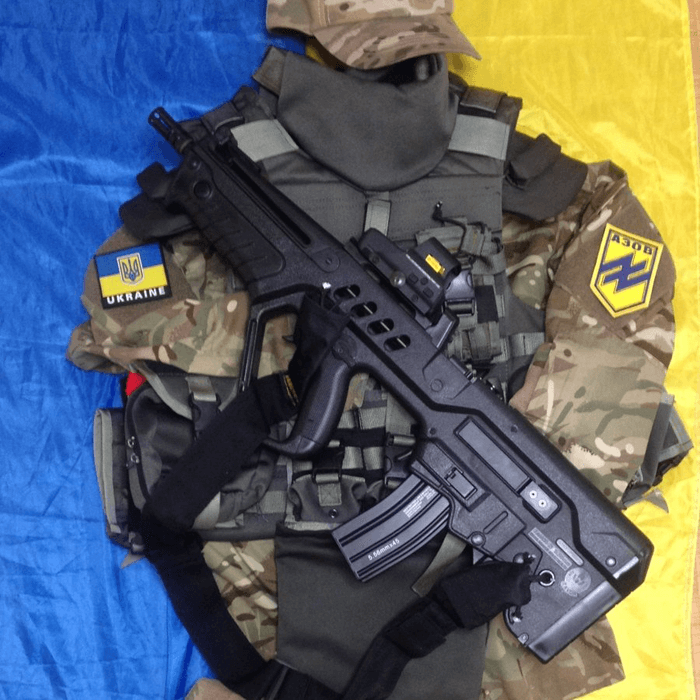
By Karl Haemers
Published by The Occidental Observer
Republished by The 21st Century
The views expressed in this article are solely those of the author and do not necessarily reflect the opinions of 21cir.com.

